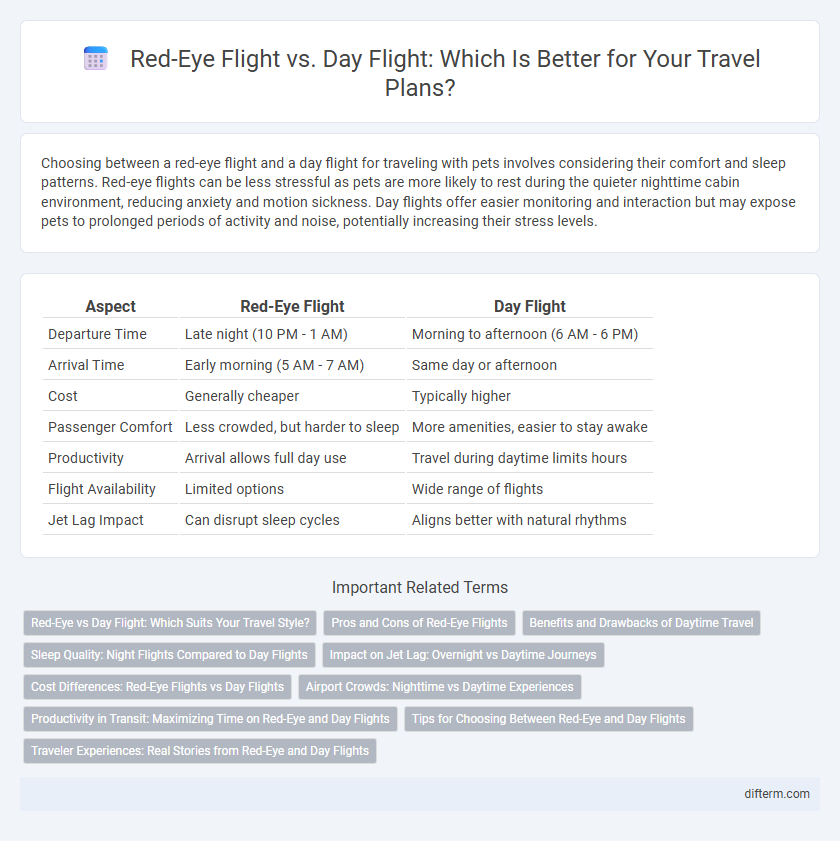Choosing between a red-eye flight and a day flight for traveling with pets involves considering their comfort and sleep patterns. Red-eye flights can be less stressful as pets are more likely to rest during the quieter nighttime cabin environment, reducing anxiety and motion sickness. Day flights offer easier monitoring and interaction but may expose pets to prolonged periods of activity and noise, potentially increasing their stress levels.
Table of Comparison
| Aspect | Red-Eye Flight | Day Flight |
|---|---|---|
| Departure Time | Late night (10 PM - 1 AM) | Morning to afternoon (6 AM - 6 PM) |
| Arrival Time | Early morning (5 AM - 7 AM) | Same day or afternoon |
| Cost | Generally cheaper | Typically higher |
| Passenger Comfort | Less crowded, but harder to sleep | More amenities, easier to stay awake |
| Productivity | Arrival allows full day use | Travel during daytime limits hours |
| Flight Availability | Limited options | Wide range of flights |
| Jet Lag Impact | Can disrupt sleep cycles | Aligns better with natural rhythms |
Red-Eye vs Day Flight: Which Suits Your Travel Style?
Red-eye flights offer cost savings and maximize daytime hours by flying overnight, ideal for travelers seeking efficiency and lower fares. Day flights provide better comfort and natural sleep cycles, suited for those who prioritize in-flight comfort and daytime arrival. Choosing between red-eye vs day flight depends on personal preferences regarding budget, convenience, and rest quality.
Pros and Cons of Red-Eye Flights
Red-eye flights offer cost savings and less crowded airports, allowing travelers to maximize daytime activities; however, they often lead to fatigue due to disrupted sleep patterns and limited in-flight services. These overnight flights can be ideal for business travelers needing early arrivals but may pose challenges for those sensitive to irregular sleep or with tight schedules. Despite convenience, red-eye flights sometimes result in increased jet lag and reduced overall comfort compared to day flights.
Benefits and Drawbacks of Daytime Travel
Daytime flights offer the benefit of increased airport and airline service availability, making check-in and customer support more accessible. Passengers can enjoy natural light, reducing jet lag and allowing easier adjustment to new time zones compared to red-eye travel. However, daytime travel often means higher ticket prices and busier airports, which can lead to longer wait times and potential flight delays.
Sleep Quality: Night Flights Compared to Day Flights
Red-eye flights often disrupt sleep quality due to cabin noise, limited reclining space, and bright cabin lights, making restful sleep challenging compared to day flights. The circadian rhythm misalignment during night flights can lead to increased fatigue and jet lag upon arrival. Conversely, day flights allow passengers to stay awake and sleep naturally at their destination, promoting better overall rest and recovery.
Impact on Jet Lag: Overnight vs Daytime Journeys
Red-eye flights often worsen jet lag due to disrupted sleep patterns and reduced quality of rest during overnight travel, impacting circadian rhythms more severely than daytime flights. Day flights typically align better with natural body clocks, allowing travelers to remain awake and adjust gradually upon arrival. Choosing daytime journeys can minimize jet lag symptoms by enabling exposure to natural daylight, which helps reset the internal clock effectively.
Cost Differences: Red-Eye Flights vs Day Flights
Red-eye flights often come with lower ticket prices compared to day flights due to reduced demand during overnight hours, making them a cost-effective option for budget-conscious travelers. Airlines may offer discounted fares on red-eye routes to maximize seat occupancy, whereas day flights typically command higher prices because of greater passenger preference and convenience. Travelers seeking to minimize travel expenses can benefit financially by choosing red-eye flights despite potential trade-offs in comfort and schedule.
Airport Crowds: Nighttime vs Daytime Experiences
Red-eye flights offer significantly less crowded airport environments, making check-in and security processes faster and more efficient during nighttime hours. Daytime flights coincide with peak travel periods, resulting in busier terminals, longer queues, and increased wait times at airport amenities. Choosing red-eye flights can enhance passenger comfort by avoiding the typical daytime hustle and bustle common at major airports.
Productivity in Transit: Maximizing Time on Red-Eye and Day Flights
Red-eye flights offer travelers the advantage of working uninterrupted overnight, leveraging quieter cabin environments to enhance focus and productivity. Day flights provide access to natural light and better in-flight amenities, facilitating tasks that require alertness and frequent breaks. Optimizing productivity depends on the nature of work and personal energy cycles, making the choice between red-eye and day flights crucial for effective time management during travel.
Tips for Choosing Between Red-Eye and Day Flights
Consider your personal sleep patterns and schedule flexibility when choosing between red-eye and day flights, as red-eye flights often save daytime hours but may disrupt rest. Evaluate factors such as arrival time convenience, airport transfers, and potential jet lag based on destination time zones. Booking flights according to business hours or leisure activities at the destination maximizes productivity and enjoyment during travel.
Traveler Experiences: Real Stories from Red-Eye and Day Flights
Travelers on red-eye flights often report greater fatigue upon arrival but appreciate saving daytime hours for activities, while day flight passengers enjoy more natural sleep patterns and easier adjustments to new time zones. Many sharing red-eye experiences mention cramped seating and limited in-flight services, contrasting with day flights' more extensive meal options and entertainment. Real stories reveal that choosing between red-eye and day flights depends on personal priorities such as maximizing destination time or comfort during travel.
red-eye flight vs day flight Infographic

 difterm.com
difterm.com